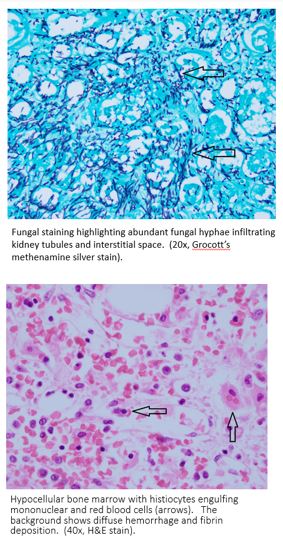Case Presentation: A 40 year-old male went camping in southeast Missouri in May and suffered tick bites. He developed a fever, rash and myalgias. He was treated with doxycycline, which was discontinued due to anaphylaxis. Due to worsening abdominal pain and fatigue he went to the hospital.
He was febrile, ill-appearing, and jaundiced. He had scattered petechiae bilaterally on his axillae and flanks. His abdominal exam was unremarkable. Laboratory evaluations revealed significant hyperbilirubinemia, elevated liver enzymes, thrombocytopenia, and neutropenia. He was empirically started on ceftriaxone for a tick-borne illness. An abdominal CT revealed hepatosplenomegaly and ascites. Infectious evaluation for viral hepatitis and tick-borne illnesses was negative. Due to clinical deterioration, his antibiotics were broadened and treatment for idiopathic thrombocytopenia purpura with intravenous immunoglobulin and steroids was initiated. However, the patient developed shock and expired after cardiac arrest.
Autopsy revealed multi-organ fungal growing Candida tropicalis. Pathology suggested hemophagocytic lymphohistiocytosis (HLH) in the liver, spleen, lymph nodes and bone marrow. He met 6/8 criteria for HLH with fever, splenomegaly, thrombocytopenia and neutropenia, elevated ferritin, elevated interleukin-2 receptor, and low natural killer cell activity.
Discussion: HLH is an uncontrolled inflammatory response of lymphocytes and macrophages. The diagnosis must fulfill five out of nine diagnostic criteria including fever, splenomegaly, bi-cytopenia, hypertriglyceridemia, hypofibrinogenemia, elevated ferritin, hemophagocytosis in the bone marrow/spleen/lymph nodes, low natural-killer cell activity, and elevated interleukin-2 receptor. Treatment of HLH involves immune-suppression with chemotherapy to suppress the hyperinflammatory and supportive care such as transfusions.
In this case, the patient’s immediate cause of death was widespread fungal infection secondary to his profound pancytopenia and liver failure. The etiology of his pancytopenia is likely related to a tick-borne illness which led to the development of HLH.
There have only been a few case reports from tick-borne related illness causing HLH in areas such as Southeast Asia and the Midwest United States. This case serves as a reminder that HLH can present as a severe clinical presentation from tick-borne illnesses. This likely predisposed the patient to develop disseminated Candida. Early diagnosis, treatment and supportive care for HLH and co-infections can improve prognosis.
Conclusions: Our patient’s clinical history suggests a tick-borne pathogen led to the development of HLH. This predisposed him to develop the disseminated Candida tropicalis infection. Unfortunately he deteriorated rapidly and died. This case emphasizes the importance to recognize the diagnostic criteria for HLH. In addition, in patient with severe neutropenia, it is important to consider beginning antifungal medications for prophylaxis.

